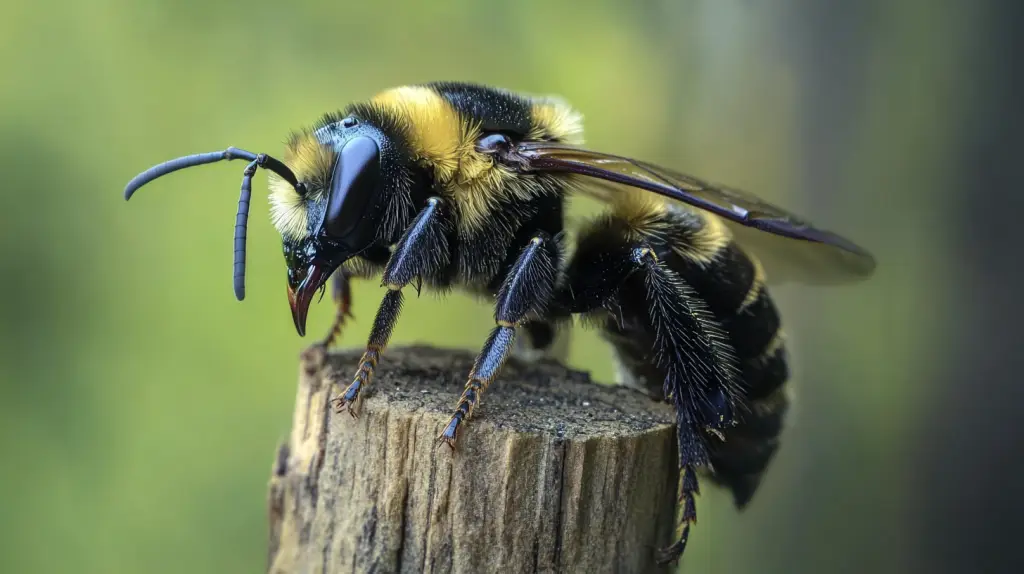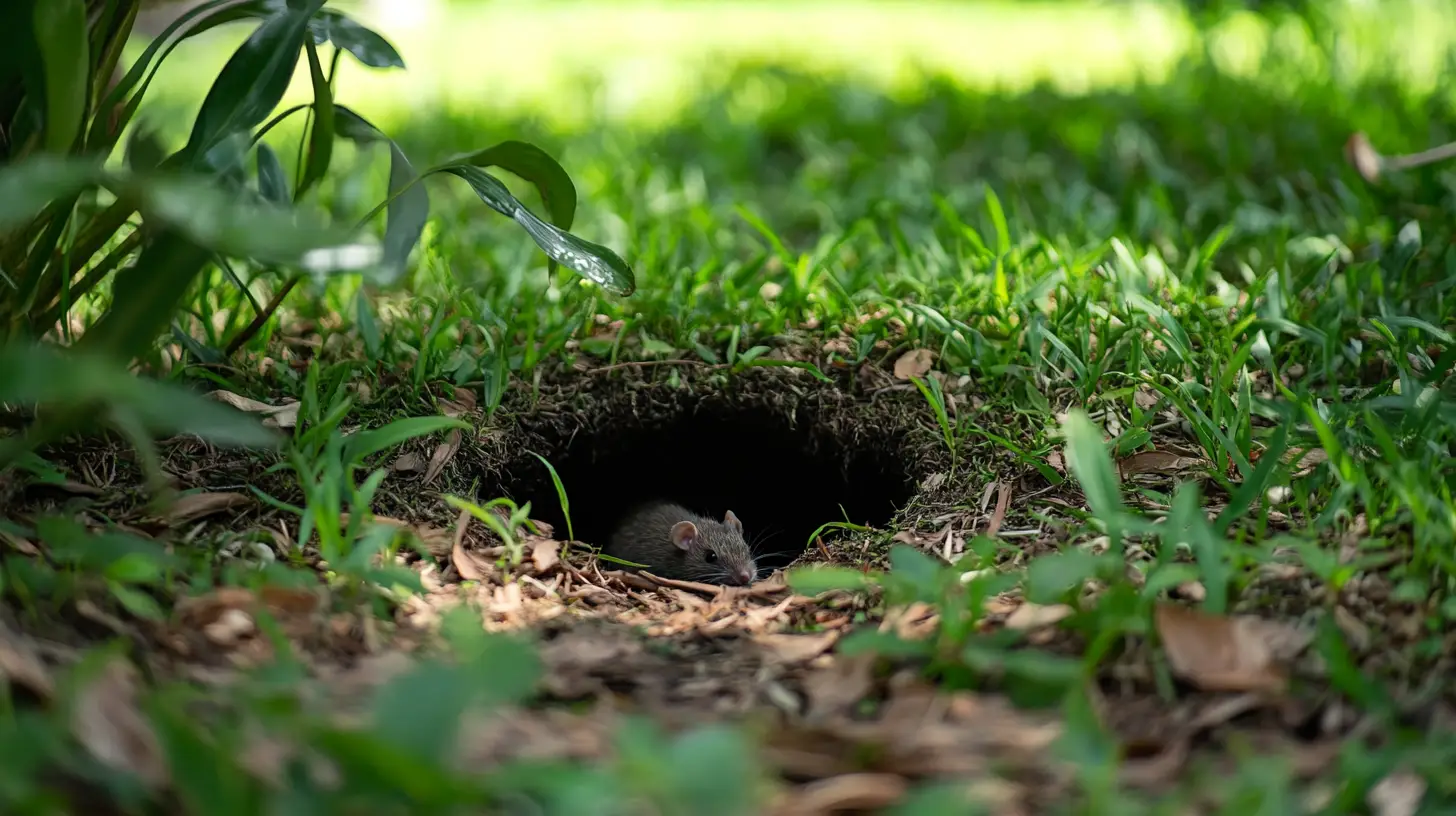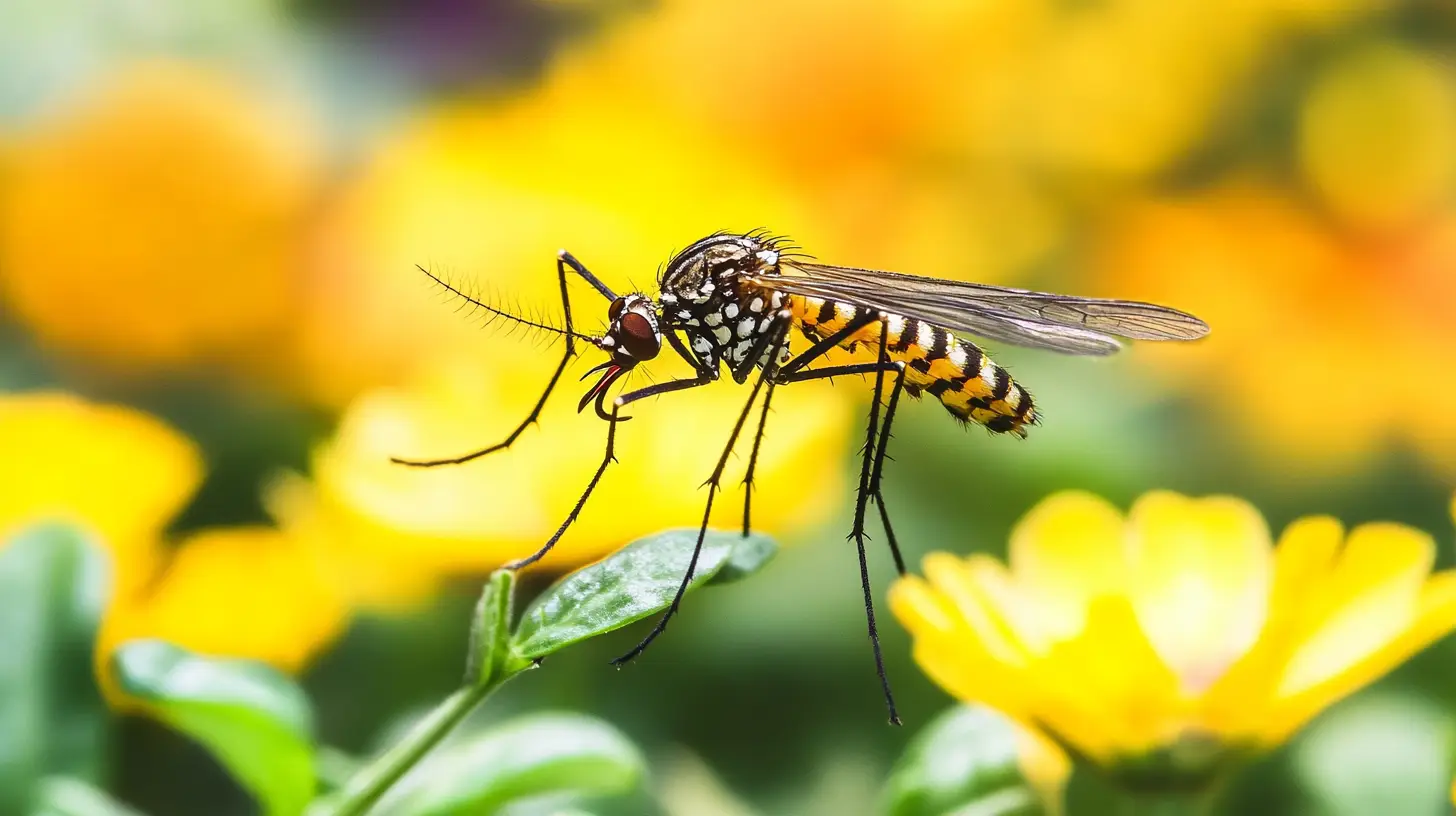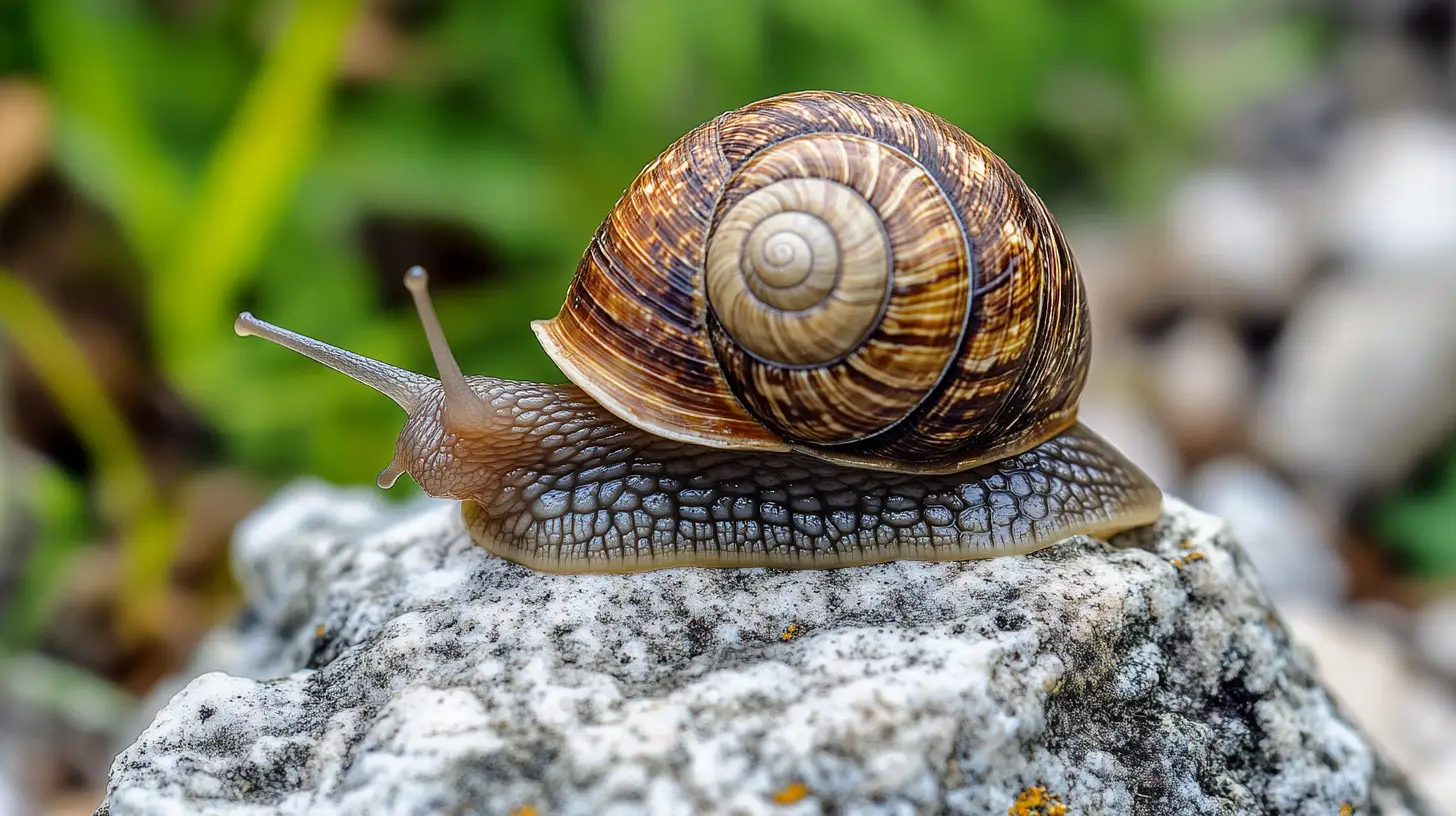
Table of Contents
Imagine relaxing on your porch, only to be interrupted by the buzzing of carpenter bees boring into your wooden structures. But, unlike termites, carpenter bees, are industrious insects that do not eat wood. Instead, they drill perfectly round holes into wood to create tunnels where they lay their eggs. These tunnels can extend several feet, consisting of a network of “galleries” that are used for nesting.
These industrious insects might seem harmless, but their relentless drilling can cause important damage over time. Understanding how to effectively get rid of carpenter bees requires more than just a can of insecticide.
Key Takeaways
- Identify Carpenter Bee Nesting Sites: Look for perfectly round holes in wooden structures to locate and target carpenter bee infestations effectively.
- Use Eco-friendly Deterrents: Employ natural methods like essential oils (citronella or tea tree) to repel bees while preserving the environment.
- Seal and Maintain Wooden Surfaces: Painting or sealing wood deters drilling by bees and prevents future infestations.
- Install Physical Barriers: Utilize wire mesh or insect netting over entry points to block bee access and protect structures.
- Consulting Professionals: For severe infestations, seek expert flying insect control services that can use targeted techniques to manage carpenter bees safely.
- Regular Inspections for Prevention: Conduct routine checks for early signs of infestation, like sawdust and bee activity, to prevent significant structural damage.
Guidelines for Safely Eliminating a Carpenter Bee Infestation
To effectively get rid of carpenter bees, start by identifying their nesting sites. Carpenter bees can cause damage to wooden structures, including decks, fences, and eaves.
Carpenter bees prefer untreated or weathered wood and typically avoid painted or pressure-treated surfaces. Seeing these openings typically indicates a carpenter bee presence, crucial for targeting treatment efforts. They often reuse their nests year after year, which can lead to further damage over time if left untreated. They may even expand the existing galleries to create larger tunnel systems.
Carpenter bees are mostly solitary creatures. Unlike honeybees, they do not form large colonies. Each female carpenter bee typically builds her own nest, although some species may nest close to one another. Carpenter bees do not produce honey. Instead, they feed on nectar, which they collect from flowers. They are important pollinators and help fertilize many types of plants.
Carpenter bees are known for their method of “buzz pollination.” They vibrate their bodies to release pollen from certain types of flowers, like tomatoes and blueberries, which require this kind of pollination for effective fertilization.
Steps to Eliminate Carpenter Bees
Carpenter bees can be nuisance pests, particularly in areas with important wooden structures, like Lakewood Ranch. You can address carpenter bee challenges using strategic methods that balance effectiveness and environmental impact.
Identifying a Carpenter Bee
Recognizing carpenter bees is crucial for effectively addressing infestations. These bees, often mistaken for bumblebees, are distinct creatures similar to their lookalikes. Unlike other bees, carpenter bees have a smooth, shiny black abdomen, whereas bumblebees display fuzzy, yellow-striped bodies. Sightings in the Lakewood Ranch area might occur from spring to early summer, coinciding with their peak activity.
Female carpenter bees are larger than the males, measuring up to one inch in length, making the size a key identifying factor. Males, although smaller, often hover around nests. They exhibit a harmless, yet territorial behavior, buzzing intimidatingly but lacking stingers. Females, armed with stingers, rarely sting unless handled or provoked.
Detecting these bees’ presence often involves noting their frequent drilling near wooden structures. They prefer untreated or weathered wood, creating near-perfect round holes roughly half an inch in diameter. If you notice sawdust piles or hear a buzzing noise near these holes, carpenter bees are likely involved.
Patrol areas like eaves, decks, and even outdoor furniture because these structures provide inviting nesting sites for carpenter bees in search of a secluded place for their eggs. Regular observation helps log their behavior, particularly during sunny days when they are most active, allowing for timely intervention to get rid of carpenter bees before important damage accumulates.
Addressing carpenter bee issues early is advantageous, especially for Lakewood Ranch residents committed to protecting their wooden homes and outdoor areas from damage. Carry out strategies to identify these creatures and enjoy a bee-free environment.
Indicators of Carpenter Bee Infestations
Spotting carpenter bee infestations involves identifying exact signs. Holes made by these bees are perfectly round and typically measure half an inch in diameter. You might notice these in exposed, untreated wooden areas like eaves, decks, and fences.
Sawdust, or frass, often accumulates beneath these entry holes. It’s a crucial indicator of active nesting. The drilling sound that accompanies nesting is another distinct sign, especially during sunny days in outdoor areas.
Pay attention to increased bee activity around your home. Carpenter bees, with their shiny black abdomens, often hover near wooden structures. Their presence can escalate in spring when they actively search for nesting sites. You may observe male bees darting around, although they don’t sting, they do protect nesting sites aggressively.
Residue or streaks on wood surfaces may indicate nesting. These appear due to bee excrement or collected pollen. Examining these signs is crucial, especially if you aim to get rid of carpenter bees and prevent further damage in your Lakewood Ranch home.
Strategies to Prevent Carpenter Bee Infestations
Effective strategies can keep carpenter bees from becoming a nuisance in your home, particularly in the Lakewood Ranch environment. Understanding their behaviors allows you to carry out prevention methods that are both sustainable and effective.
- Seal Wood Surfaces: Protective coatings on wood surfaces deter carpenter bees from drilling. Use paint or varnish, as bees prefer bare wood for nesting. Regular maintenance of these coatings prolongs their effectiveness, especially in outdoor areas around decks and eaves.
- Use Essential Oils: Essential oils like citronella and tea tree deter carpenter bees naturally. Apply oils mixed with water to wooden surfaces. Refresh the application every few weeks for continued protection, particularly during active bee seasons.
- Install Physical Barriers: Physical barriers like wire mesh or metal flashing cover potential entry points. Focusing on vulnerable areas such as soffits and fascia prevents bees from accessing the wood.
- Conduct Regular Inspections: Routine inspections help detect early signs of activity. Look for round holes and sawdust (frass) around wooden structures. Early detection allows for prompt action, reducing damage.
- Use Natural Predators: Encourage natural predators like birds to frequent your property by installing birdhouses. Protect your garden while maintaining ecological balance by allowing these natural controls to take part in your prevention efforts.
- Carry out Noise Deterrents: Noise deterrents can be effective if bees have already begun nesting. The vibrations from devices like sound waves disrupt bee activity, encouraging them to leave.
Captivating with these strategies offers localized and environmentally friendly answers to manage and prevent carpenter bee infestations in Lakewood Ranch. By employing these targeted methods, you maintain structural integrity and preserve the network.
Methods to Eradicate Carpenter Bees
Taking control of carpenter bees in Lakewood Ranch means implementing targeted methods that protect wood structures while respecting the environment. With a blend of practical and expert-recommended techniques, you ensure effective management of these persistent pests.
Use Natural Oils
Deter carpenter bees with essential oils, such as citronella or tea tree oil. These oils create a natural barrier, discouraging bees without harming them. Mix the oil with water in a spray bottle and apply it to affected areas, focusing on entry points and wooden surfaces.
Paint and Varnish
Seal wooden surfaces by applying paint or varnish, creating an unattractive environment for bees. This simple step not only beautifies your structures but also protects them from bee infestations.
Install Barriers
Physical barriers, like wire mesh or screens, block access to entry holes. Secure these barriers over known nesting sites to prevent bees from returning.
Apply Insecticide Dust
Use insecticide dust specifically labeled for carpenter bees. This method targets bees directly in their nests. Apply the dust inside entry holes during quieter times of the day, such as early evening, to disrupt their colonization.
Sound Deterrents
Noise can also serve as a deterrent. By installing ultrasonic devices around the home, create an environment that makes it uncomfortable for bees to settle, ensuring they seek new nesting areas away from your property.
Enlist Professionals
Severe infestations might require professional intervention. Experts in Lakewood Ranch have the tools and knowledge to eradicate carpenter bees safely, often employing methods that minimize disturbance to the network.
These strategies, specifically customized for Lakewood Ranch, create a balanced approach to getting rid of carpenter bees, ensuring your home’s protection while maintaining ecological harmony.
Steps to Eliminate Carpenter Bees
Dealing with carpenter bees involves strategic steps to protect wooden structures. These methods focus on immediate removal and long-term prevention, emphasizing a balanced approach that respects the local Lakewood Ranch environment.
1: Apply Residual Insecticide to Eradicate Carpenter Bees
Begin by using a residual insecticide designed for carpenter bees. This creates a barrier that deters bees from re-entering their nests. Apply in the late afternoon or evening when bees are less active. Look for insecticides that are environmentally safe to minimize impact on non-target species and groundwater.
2: Insert Dust into Carpenter Bee Nests
Using insecticide dust can be highly effective in treating carpenter bee nests. Insert the dust directly into the entry holes using a puffer duster. This method targets the bees’ nesting areas and helps eliminate them by reaching the larvae. Cover the holes after a few days to block reentry.
3: Seal Carpenter Bee Holes
After treating with insecticides, seal the entry holes with wood putty or a similar material to prevent future infestations. Painting over treated areas further deters bees, as they prefer bare wood. Regular maintenance of wooden surfaces reduces vulnerability to these pests.
Optional Step: A Natural Non-Chemical Method
For those preferring a natural approach, essential oils like citronella, tea tree, or almond can deter carpenter bees. Apply these oils near entry points and exposed wood surfaces. Also, installing physical barriers such as wire mesh can keep bees at bay without impacting local wildlife. Encouraging natural predators, like birds, enhances this eco-friendly strategy, adding a layer of protection that aligns with the biodiversity of Lakewood Ranch.
Identifying a Carpenter Bee
Recognizing carpenter bees and distinguishing them from other bees is crucial when managing infestations. These bees, often mistaken for their cousins, bumblebees, have a distinct appearance that aids in proper identification. Unlike bumblebees, carpenter bees possess a shiny, black abdomen, devoid of hair. Female carpenter bees, larger than males, usually reach an inch in length. Observing their flight patterns can also provide clues—they tend to hover near wooden structures, while bumblebees typically stay close to flowers.
In Lakewood Ranch, these bees often choose untreated or weathered wood as ideal nesting sites. You might notice perfectly round entry holes on eaves or decks, indicative of carpenter bee activity. These holes, about half an inch in diameter, mark the beginning of their elaborate nesting tunnels. Listen for faint drilling sounds on warm days, as this can signify active infestation.
Environmental signs further confirm their presence. The accumulation of sawdust (frass) beneath entry holes indicates current tunneling. Also, male carpenter bees display territorial behavior, aggressively hovering near nest entrances. This behavior serves as another distinguishing characteristic, as they attempt to ward off perceived threats.
Do Carpenter Bees Sting?
Carpenter bees, though intimidating in appearance, have a unique relationship with humans and the environment. Females have stingers but sting only under important provocation, making them less harmful in routine human encounters, they are generally docile and will only sting if directly provoked.
If you’re more likely to encounter the male carpenter bee, you’ll find they’re actually stingless. Even though their stingless nature, males display aggressive territorial behavior, often hovering around nesting sites. Although male carpenter bees are completely harmless to humans.
Understanding these bees’ behavior enhances efforts to get rid of carpenter bees effectively. Without the fear of frequent stings, you can approach elimination with confidence, knowing the risk of harm remains minimal. With female bees generally passive unless provoked, applying preventive measures like those detailed in your strategic approach minimizes adverse interactions while preserving ecological balance.
In Lakewood Ranch, where appreciation for outdoor living is high, knowing that carpenter bees rarely sting transforms these insects from feared to manageable. Maintaining respect for their role in the network while managing potential structural damage allows you to protect your space effectively. Remember that while their presence could cause damage, carpenter bees contribute to pollination and biodiversity. Being aware of their behavior aids in maintaining harmony between humans and bees, making the process of getting rid of carpenter bees a more informed try.
Indicators of Carpenter Bee Infestations
Identifying carpenter bee infestations early is crucial to preventing damage. Look for exact signs when assessing potential problems.
Carpenter Bee Kits: Combining Insecticides and Dusts
Carpenter bee kits use a mix of insecticides and dusts to target infestations. These kits offer comprehensive answers with applicator tools for accurate delivery. Dust settles deep into tunnels, eliminating larvae and deterring future use. Kits also include residual sprays to protect wood and create a formidable barrier, ideal for Lakewood Ranch’s climate.
Attention to frass (sawdust) piles near holes can signal active nests. Increased bee activity, especially near untreated wood, indicates infestations. Regular inspections and proactive use of carpenter bee kits effectively get rid of carpenter bees, ensuring structural integrity.
How to Deter Woodpeckers
Woodpeckers often follow carpenter bees, attracted by the larvae within the wooden structures. Prevention methods effectively minimize this issue. First, install physical deterrents like netting to cover exposed wood surfaces. Netting preserves the natural look of your home yet blocks access to woodpeckers.
Create visual distractions to deter woodpeckers. Hanging reflective objects, such as CDs or aluminum foil strips, can confuse them. These elements reflect sunlight, creating an unsettling environment for woodpeckers. Adjust them periodically to maintain their effectiveness.
Use noise deterrents to dissuade woodpeckers. Metal chimes or ultrasonic devices in areas of high activity create an unwelcoming atmosphere. Sound fluctuates, making it hard for woodpeckers to settle or locate nesting sites.
Seal any existing holes promptly. If woodpeckers have already pecked at structures in search of carpenter bee larvae, repair these areas with wood filler or putty. Following repairs, apply paint or varnish to reinforce the surface and deter further drilling.
Promote biodiversity with natural predators. Encourage birds, like hawks or owls, to visit your yard. Installing birdhouses or providing a food source can attract these natural woodpecker predators, contributing to a balanced ecological environment in Lakewood Ranch.
Year-Round Tips for Carpenter Bee Prevention
Proactively preventing carpenter bee issues ensures peace of mind and protects wood structures.
Maintain Wooden Surfaces
Painting or sealing wood surfaces prevents bees from drilling. Choose high-quality paint or a clear sealant for long-lasting protection. Apply these coatings in optimal weather conditions for best results.
Install Physical Barriers
Wire mesh and metal sheeting effectively block bees’ access to potential entry points. Install barriers over vulnerable areas such as eaves and undersides of decks. Ensure they fit securely to prevent bee entry.
Use Essential Oils
Natural deterrents like citronella and tea tree oil discourage carpenter bees. Mix these oils with water, then spray them on exposed wood regularly. This eco-friendly method repels without harming bees or the environment.
Encourage Natural Predators
Attracting bird species that prey on carpenter bees can control their population. Installing birdhouses around your property invites these predators, promoting a natural balance. Consider species native to Lakewood Ranch to maintain local biodiversity.
Conduct Regular Inspections
Frequent checks for signs of carpenter bee activity, such as frass or entry holes, help catch problems early. Inspect during daylight hours when bees are active. This allows for timely interventions to prevent further structural damage.
Use Noise Deterrents
Ultrasonic devices emit sounds that irritate carpenter bees. Place these devices in areas of high bee activity for maximum effectiveness. This method complements other prevention strategies, creating an uninviting environment for bees.
Engage Professionals for Persistent Issues
Consulting entomologists or professional flying insect control services provides expert answers for severe infestations. These professionals can use specialized techniques to safely manage and prevent carpenter bee problems, safeguarding your property.
Frequently Asked Questions (FAQs)
What are the common signs of a carpenter bee infestation?
Carpenter bee infestations can be identified by the presence of perfectly round holes on wooden surfaces, typically half an inch in diameter. Other indicators include sawdust accumulation (frass) beneath entry holes, increased bee activity near wood, and aggressive male bees hovering around nesting sites. Observing these signs allows homeowners to address issues promptly and prevent further damage to their structures.
How can I prevent carpenter bees from damaging my wooden structures?
Prevent carpenter bee infestations by sealing wood surfaces with protective coatings like paint or varnish. Installing physical barriers such as wire mesh over potential entry points is effective. Using essential oils like citronella or tea tree oil acts as a natural deterrent. Regular inspections and the encouragement of natural predators, such as birds, also help in maintaining bee-free environments.
Why are natural methods recommended for managing carpenter bees?
Natural methods are recommended because they effectively deter carpenter bees without harming the environment. Using solutions like essential oils helps maintain ecological balance while protecting structures. These methods support biodiversity and pollination, crucial for the ecosystem, allowing homeowners to manage bees responsibly without resorting to chemicals.
What should I do if the infestation is too severe to handle on my own?
For severe carpenter bee infestations, it is advisable to consult professionals. Experts have specialized equipment and techniques to safely and effectively remove bees while minimizing disruption to both the environment and your home. This approach ensures that the problem is managed thoroughly and reduces the risk of recurring infestations.
How can I accurately identify carpenter bees around my home?
Carpenter bees are often confused with bumblebees but can be identified by their smooth, shiny black abdomens. Females are larger and can reach up to one inch in length. They prefer untreated or weathered wood and create round holes for nesting. Watching for sawdust beneath these holes and listening for faint drilling sounds can confirm their presence.
Are carpenter bees dangerous to humans?
Carpenter bees pose minimal risk to humans. While female bees can sting, they typically do so only when provoked. Male bees display aggressive behavior but lack stingers, making them harmless. Understanding their behavior helps in managing infestations confidently, knowing that preventive actions can be taken without frequent stings.
How do carpenter bees contribute to the ecosystem?
Carpenter bees play an essential role in pollination, contributing to the biodiversity of many environments. By managing these bees thoughtfully using natural methods, we protect their ecological role while preventing structural damage, fostering harmony between humans and nature in outdoor living spaces.









